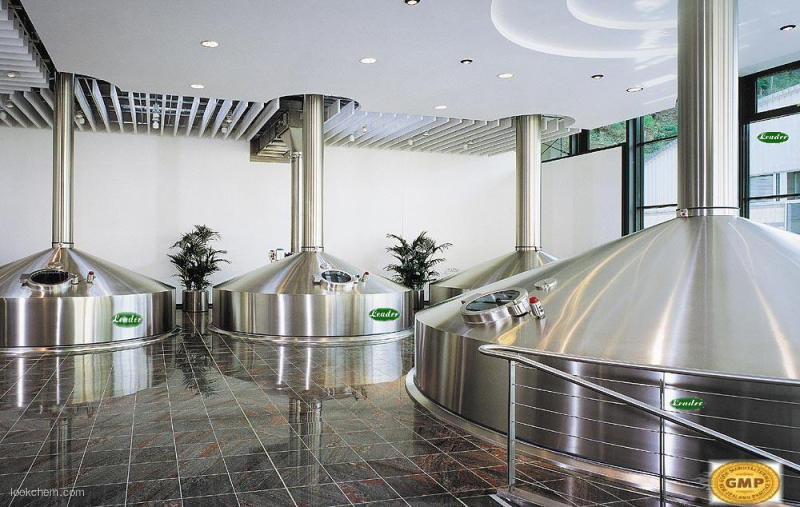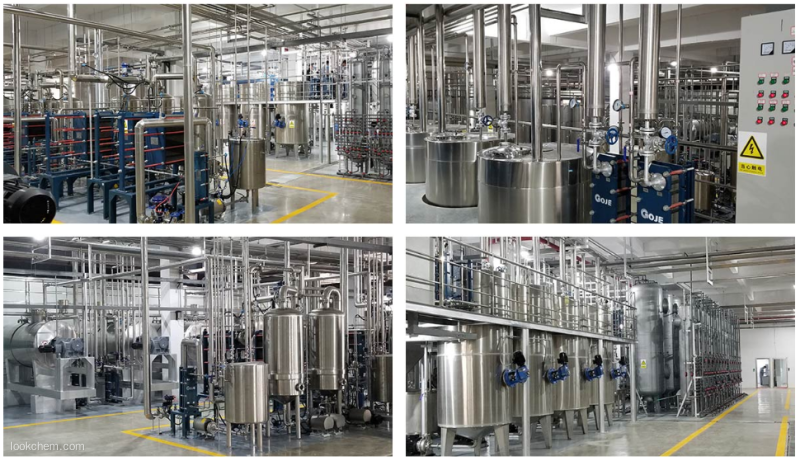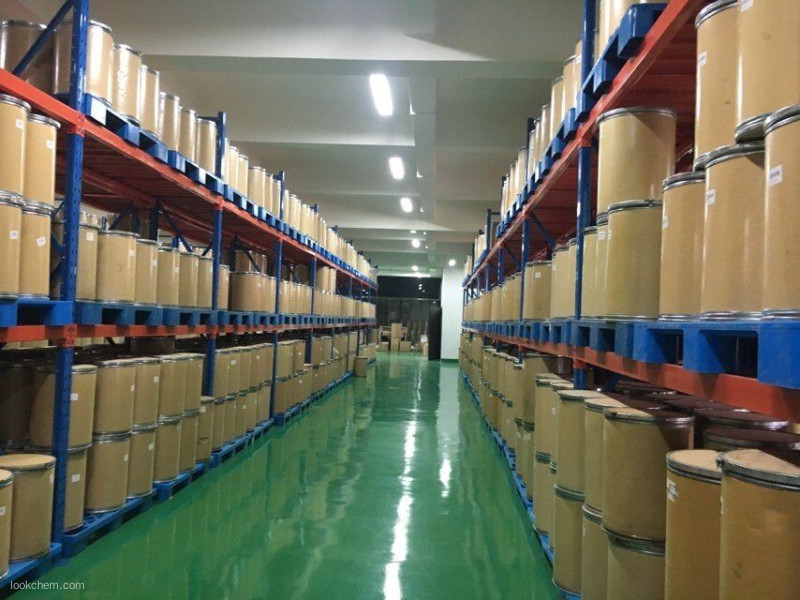PRODUCT DETAILS
| |
| Calcium phosphate dibasic Chemical Properties |
| Melting point |
370°C(decomposition) |
| density |
2.306(16℃) |
| RTECS |
TB8528000 |
| storage temp. |
2-8°C |
| solubility |
Practically insoluble in water and in ethanol (96 per cent). It dissolves in dilute hydrochloric acid and in dilute nitric acid. |
| form |
gel (aged) |
| color |
White |
| PH |
7 (10g/l, H2O, 20°C) suspension |
| Water Solubility |
Sparingly soluble in water, practically insoluble in cold water. |
| Merck |
13,1697 |
| Solubility Product Constant (Ksp) |
pKsp: 7 |
| Stability: |
Stable. Incompatible with strong oxidizing agents. |
| InChIKey |
FUFJGUQYACFECW-UHFFFAOYSA-L |
| CAS DataBase Reference |
7757-93-9(CAS DataBase Reference) |
| EPA Substance Registry System |
Calcium hydrogen phosphate (7757-93-9) |
| Provider |
Language |
| SigmaAldrich |
English |
| ACROS |
English |
| ALFA |
English |
| |
| Calcium phosphate dibasic Usage And Synthesis |
| Chemical Properties |
Dibasic Calcium Phosphate is anhydrous or contains two molecules of water of hydration. It occurs as a white, odorless, tasteless powder that is stable in air. It is practically insoluble in water, but is readily soluble in dilute hydrochloric and nitric acids. It is insoluble in alcohol.

Dibasic calcium phosphate is produced by the reaction of phosphoric acid, calcium chloride, and sodium hydroxide. Calcium carbonate can be used in place of the calcium chloride and sodium hydroxide.
Dibasic calcium phosphate anhydrous is generally regarded as relatively nontoxic and nonirritant material. It is widely used in oral pharmaceutical products and food products.
Functional Use in Foods: Leavening agent; dough conditioner; nutrient; dietary supplement; yeast food. |
| Uses |
Dibasic calcium phosphate is found in nature as the mineral monetite. It is used as a food supplement and source of calcium, both in human food and animal feed. It is used in dough conditioner; in several dental products and in medicine. Other applications are in fertilizers, plastics and in the manufacture of glass. |
| Preparation |
Dibasic calcium hydrogen phosphate may be prepared by several methods.
It is precipitated by mixing solutions of calcium chloride and disodium hydrogen phospate: CaCl2 + Na2HPO4 → CaHPO4 + 2NaCl
It also is prepared by treating phosphoric acid with lime water (suspension of calcium hydroxide in water). Also, it is obtained as a by-product in the preparation of hydroxypatite. The preparation involves the reaction of phosphoric acid with calcium phosphate.
H3PO4 + Ca3(PO4)2 → 3CaHPO4 |
| Chemical Properties |
Anhydrous dibasic calcium phosphate is a white, odorless, tasteless powder or crystalline solid. It occurs as triclinic crystals. |
| Physical properties |
White triclinic crystal; density 2.92 g/cm3 (anhydrous) and 2.31 g/cm3 (dihy drate); hardness 3.5 Mohs; decomposes on heating; inosluble in water and alcohol; KSP 2.7x10-7; soluble in dilute mineral acid. |
| Uses |
It is used as a feed additive for livestock and poultry. It can promote feed digestion, put on animal s weight, raise laying rate or producing milk rate, cure diseases such as rickets, osteomalacia and anemia. |
| Uses |
Replenisher (calcium); pharmaceutic aid (tablet base). |
| Production Methods |
Calcium phosphates are usually prepared by reacting very pure phosphoric acid with calcium hydroxide, Ca(OH)2 obtained from limestone, in stoichiometric ratio in aqueous suspension followed by drying at a temperature that will allow the correct hydration state to be achieved. After drying, the coarse-grade material is obtained by means of a classification unit; the fine particle-size material is obtained by milling. Dibasic calcium phosphate, anhydrous, may also be prepared by spray-drying. |
| Brand name |
CalStar (FMC); D.C.P. (Parke-Davis). |
| Pharmaceutical Applications |
Anhydrous dibasic calcium phosphate is used both as an excipient and as a source of calcium in nutritional supplements. It is used particularly in the nutritional/health food sectors. It is also used in pharmaceutical products because of its compaction properties, and the good flow properties of the coarse-grade material. The predominant deformation mechanism of anhydrous dibasic calcium phosphate coarse-grade is brittle fracture and this reduces the strain-rate sensitivity of the material, thus allowing easier transition from the laboratory to production scale. However, unlike the dihydrate, anhydrous dibasic calcium phosphate when compacted at higher pressures can exhibit lamination and capping. This phenomenon can be observed when the material represents a substantial proportion of the formulation, and is exacerbated by the use of deep concave tooling. This phenomenon also appears to be independent of rate of compaction.
Anhydrous dibasic calcium phosphate is abrasive and a lubricant is required for tableting, for example 1% w/w magnesium stearate or 1% w/w sodium stearyl fumarate.
Two particle-size grades of anhydrous dibasic calcium phosphate are used in the pharmaceutical industry. Milled material is typically used in wet-granulated or roller-compacted formulations. The ‘unmilled’ or coarse-grade material is typically used in directcompression formulations.
Anhydrous dibasic calcium phosphate is nonhygroscopic and stable at room temperature. It does not hydrate to form the dihydrate.
Anhydrous dibasic calcium phosphate is used in toothpaste and dentifrice formulations for its abrasive properties. |
| Agricultural Uses |
Dicalcium phosphate (CaHPO4) is made from calcium carbonate and phosphoric acid. It contains 34% citrate- soluble phosphorus pentoxide (P2O5). It is not commonly used as a fertilizer, but is used as a supplement to animal feed. |
| Safety Profile |
Skin and eye irritant. A nuisance dust. |
| Safety |
Dibasic calcium phosphate anhydrous is widely used in oral pharmaceutical products, food products, and toothpastes, and is generally regarded as a relatively nontoxic and nonirritant material. |
| storage |
Dibasic calcium phosphate anhydrous is a nonhygroscopic, relatively stable material. Under conditions of high humidity it does not hydrate to form the dihydrate.
The bulk material should be stored in a well-closed container in a dry place. |
| Purification Methods |
Crystallise it from a near-saturated solution in 50% aqueous reagent grade phosphoric acid at 100o by filtering through fritted glass and cooling to room temperature. The crystals are filtered off, and this process is repeated three times using fresh acid. For the final crystallisation the solution is cooled slowly with constant stirring to give thin plate crystals that are filtered off on a fritted glass funnel, washed free of acid with anhydrous acetone and dry in a vacuum desiccator [Egan et al.J Am Chem Soc 78 1811 1956]. |
| Incompatibilities |
Dibasic calcium phosphate should not be used to formulate tetracyline antibiotics.
The surface of milled anhydrous dibasic calcium phosphate is alkaline and consequently it should not be used with drugs that are sensitive to alkaline pH. However, reports suggest there are differences in the surface alkalinity/acidity between the milled and unmilled grades of anhydrous dibasic calcium phosphate; the unmilled form has an acidic surface environment. This difference has important implications for drug stability, particularly when reformulating from, e.g. roller compaction to direct compression, when the particle size of the anhydrous dibasic calcium phosphate might be expected to change.
Dibasic calcium phosphate dihydrate has been reported to be incompatible with a number of drugs and excipients, and many of these incompatibilities are expected to occur with dibasic calcium phosphate, anhydrous; see Calcium phosphate, dibasic dihydrate. |
| Regulatory Status |
GRAS listed. Accepted as a food additive in Europe. Included in the FDA Inactive Ingredients Database (oral capsules and tablets). Included in nonparenteral medicines licensed in Europe. Included in the Canadian List of Acceptable Non-medicinal Ingredients. |
| |
| Calcium phosphate dibasic Preparation Products And Raw materials |
|
|
|
|
|
|
About Our Group
Leader Biochemical Group is a large leader incorporated industry manufacturers and suppliers of advanced refined raw materials From the year of 1996 when our factory was put into production to year of 2020, our group has successively invested in more than 52 factories with shares and subordinates.We focus on manufacture Pharm & chemicals, functional active ingredients, nutritional Ingredients, health care products, cosmetics, pharmaceutical and refined feed, oil, natural plant ingredients industries to provide top quality of GMP standards products.All the invested factories' product lines cover API and intermediates, vitamins, amino acids, plant extracts, daily chemical products, cosmetics raw materials, nutrition and health care products, food additives, feed additives, essential oil products, fine chemical products and agricultural chemical raw materials And flavors and fragrances. Especially in the field of vitamins, amino acids, pharmaceutical raw materials and cosmetic raw materials, we have more than 20 years of production and sales experience. All products meet the requirements of high international export standards and have been recognized by customers all over the world. Our manufacture basement & R&D center located in National Aerospace Economic & Technical Development Zone Xi`an Shaanxi China. Now not only relying on self-cultivation and development as well as maintains good cooperative relations with many famous research institutes and universities in China. Now, we have closely cooperation with Shanghai Institute of Organic Chemistry of Chinese Academy of Science, Beijing Institute of Material Medical of Chinese Academy of Medical Science, China Pharmaceutical University, Zhejiang University. Closely cooperation with them not only integrating Science and technology resources, but also increasing the R&D speed and improving our R&D power. Offering Powerful Tech supporting Platform for group development. Keep serve the manufacture and the market as the R&D central task, focus on the technical research. Now there are 3 technology R & D platforms including biological extract, microorganism fermentation and chemical synthesis, and can independently research and develop kinds of difficult APIs and pharmaceutical intermediates. With the strong support of China State Institute of Pharmaceutical Industry (hereinafter short for CSIPI), earlier known as Shanghai Institute of Pharmaceutical Industry (SIPI), we have unique advantages in the R & D and industrialization of high-grade, precision and advanced products. Now our Group technical force is abundant, existing staff more that 1000 people, senior professional and technical staff accounted for more than 50% of the total number of employees, including 15 PhD research and development personnel, 5 master′ S degree in technical and management personnel 9 people. We have advanced equipment like fermentation equipment and technology also extraction, isolation, purification, synthesis with rich production experience and strict quality control system, According to the GMP required, quickly transforming the R&D results to industrial production in time, it is our advantages and our products are exported to North and South America, Europe, Middle East, Africa, and other five continents and scale the forefront in the nation, won good international reputation. We believe only good quality can bring good cooperation, quality is our key spirit during our production, we are warmly welcome clients and partner from all over the world contact us for everlasting cooperation, Leader will be your strong, sincere and reliable partner in China.
Our Group profiles
Our Factories production lines



Our Factories R&D ability


Our Factories warehouse




 Premiumsupplier
Premiumsupplier 



